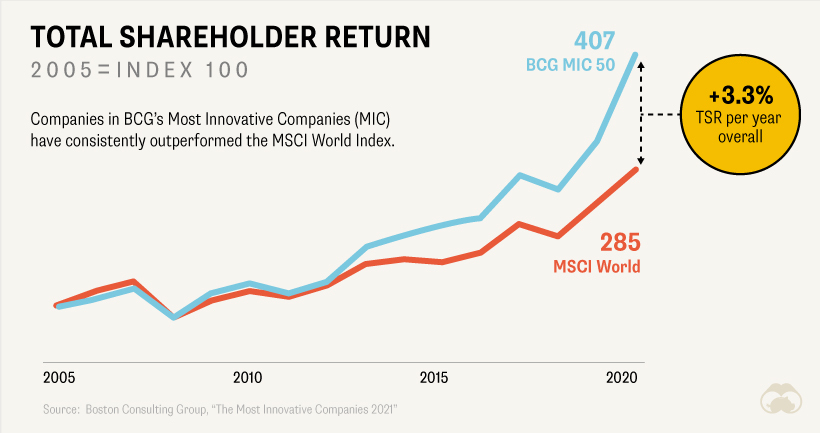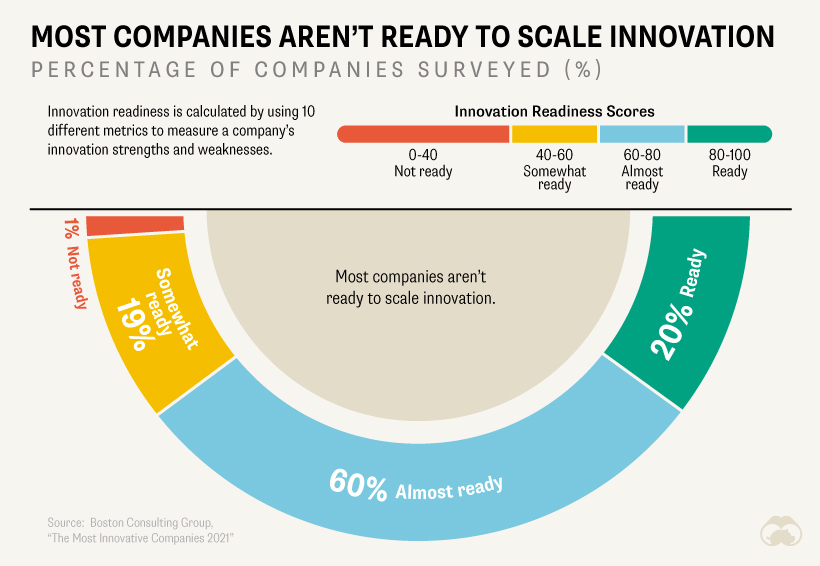Using data from the annual ranking done by Boston Consulting Group (BCG) using a poll of 1,600 global innovation professionals, this graphic ranks the top 50 most innovative companies in 2021. We’ll dig into a few of the leading companies, along with their innovative practices, below.
Most Innovative Companies: A Breakdown of the Leaderboard
To create the top 50 innovative company ranking, BCG uses four variables:
Global “Mindshare”: The number of votes from all innovation executives. Industry Peer Review: The number of votes from executives in a company’s industry. Industry Disruption: A diversity index to measure votes across industries. Value Creation: Total share return.
For the second year in a row, Apple claims the top spot on this list. Here’s a look at the full ranking for 2021: One company worth touching on is Pfizer, a returnee from previous years that ranked 10th in this year’s ranking. It’s no surprise that Pfizer made the list, considering its instrumental role in the fight against COVID-19. In partnership with BioNTech, Pfizer produced a COVID-19 vaccine in less than a year. This is impressive considering that, historically, vaccine development could take up to a decade to complete. Pfizer is just one of four COVID-19 vaccine producers to appear on the list this year—Moderna, Johnson & Johnson, and AstraZeneca also made the cut. Meanwhile, in a completely different industry, Toyota snagged the 21st spot on this year’s list, up 20 places compared to the rankings in the previous year. This massive jump can be signified by the company’s recent $400 million investment into a company set to build flying electric cars. While we often think of R&D and innovation as being synonymous, the former is just one innovation technique that’s helped companies earn a spot on the list. Other companies have innovated in different ways, like streamlining processes to increase efficiency. For instance, in 2021, Coca-Cola performed an analysis of their beverage portfolio and ended up cutting their brand list in half, from 400 to 200 global brands. This ability to pare down and pivot could be a reason behind its 20 rank increase from 2020.
Innovation Creates Value
As this year’s ranking indicates, innovation comes in many forms. But, while there’s no one-size-fits-all approach, there is one fairly consistent innovation trend—the link between innovation and value. In fact, according to historical data from BCG, the correlation between value and innovation has grown even stronger over the last two decades.
For example, in 2020, a portfolio that was theoretically invested in BCG’s most innovative companies would have performed 17% better than the MSCI World Index—which wasn’t the case back in 2005. And yet, despite innovation’s value, many companies can’t reap the benefits that innovation offers because they aren’t ready to scale their innovative practices.
The Innovation Readiness Gap
BCG uses several metrics to gauge a company’s “innovation readiness,” such as the strength of its talent and culture, its organization ecosystems, and its ability to track performance. According to BCG’s analysis, only 20% of companies surveyed were ready to scale on innovation.
What’s holding companies back from reaching their innovation potential? The most significant gap seems to be in what BCG calls innovation practices—things like project management or the ability to execute an idea that’s both efficient and consistent with an overarching strategy. To overcome this obstacle, BCG says companies need to foster a “one-team mentality” to increase interdepartmental collaboration and align team incentives, so everyone is working towards the same goal. on But fast forward to the end of last week, and SVB was shuttered by regulators after a panic-induced bank run. So, how exactly did this happen? We dig in below.
Road to a Bank Run
SVB and its customers generally thrived during the low interest rate era, but as rates rose, SVB found itself more exposed to risk than a typical bank. Even so, at the end of 2022, the bank’s balance sheet showed no cause for alarm.
As well, the bank was viewed positively in a number of places. Most Wall Street analyst ratings were overwhelmingly positive on the bank’s stock, and Forbes had just added the bank to its Financial All-Stars list. Outward signs of trouble emerged on Wednesday, March 8th, when SVB surprised investors with news that the bank needed to raise more than $2 billion to shore up its balance sheet. The reaction from prominent venture capitalists was not positive, with Coatue Management, Union Square Ventures, and Peter Thiel’s Founders Fund moving to limit exposure to the 40-year-old bank. The influence of these firms is believed to have added fuel to the fire, and a bank run ensued. Also influencing decision making was the fact that SVB had the highest percentage of uninsured domestic deposits of all big banks. These totaled nearly $152 billion, or about 97% of all deposits. By the end of the day, customers had tried to withdraw $42 billion in deposits.
What Triggered the SVB Collapse?
While the collapse of SVB took place over the course of 44 hours, its roots trace back to the early pandemic years. In 2021, U.S. venture capital-backed companies raised a record $330 billion—double the amount seen in 2020. At the time, interest rates were at rock-bottom levels to help buoy the economy. Matt Levine sums up the situation well: “When interest rates are low everywhere, a dollar in 20 years is about as good as a dollar today, so a startup whose business model is “we will lose money for a decade building artificial intelligence, and then rake in lots of money in the far future” sounds pretty good. When interest rates are higher, a dollar today is better than a dollar tomorrow, so investors want cash flows. When interest rates were low for a long time, and suddenly become high, all the money that was rushing to your customers is suddenly cut off.” Source: Pitchbook Why is this important? During this time, SVB received billions of dollars from these venture-backed clients. In one year alone, their deposits increased 100%. They took these funds and invested them in longer-term bonds. As a result, this created a dangerous trap as the company expected rates would remain low. During this time, SVB invested in bonds at the top of the market. As interest rates rose higher and bond prices declined, SVB started taking major losses on their long-term bond holdings.
Losses Fueling a Liquidity Crunch
When SVB reported its fourth quarter results in early 2023, Moody’s Investor Service, a credit rating agency took notice. In early March, it said that SVB was at high risk for a downgrade due to its significant unrealized losses. In response, SVB looked to sell $2 billion of its investments at a loss to help boost liquidity for its struggling balance sheet. Soon, more hedge funds and venture investors realized SVB could be on thin ice. Depositors withdrew funds in droves, spurring a liquidity squeeze and prompting California regulators and the FDIC to step in and shut down the bank.
What Happens Now?
While much of SVB’s activity was focused on the tech sector, the bank’s shocking collapse has rattled a financial sector that is already on edge.
The four biggest U.S. banks lost a combined $52 billion the day before the SVB collapse. On Friday, other banking stocks saw double-digit drops, including Signature Bank (-23%), First Republic (-15%), and Silvergate Capital (-11%).
Source: Morningstar Direct. *Represents March 9 data, trading halted on March 10.
When the dust settles, it’s hard to predict the ripple effects that will emerge from this dramatic event. For investors, the Secretary of the Treasury Janet Yellen announced confidence in the banking system remaining resilient, noting that regulators have the proper tools in response to the issue.
But others have seen trouble brewing as far back as 2020 (or earlier) when commercial banking assets were skyrocketing and banks were buying bonds when rates were low.















